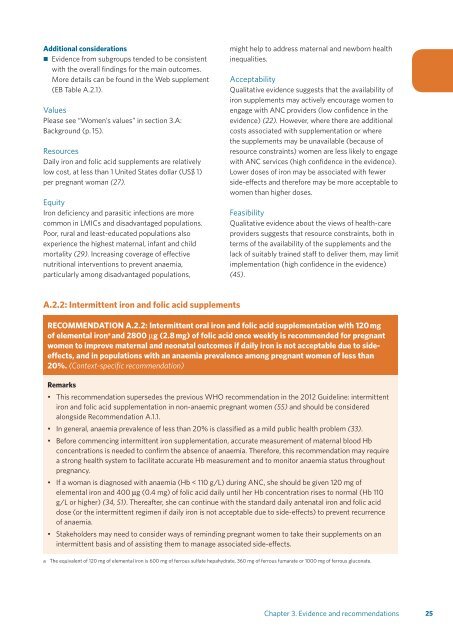WHO recommendations on antenatal care for a positive pregnancy experience
5pAUd5Zhw
5pAUd5Zhw
You also want an ePaper? Increase the reach of your titles
YUMPU automatically turns print PDFs into web optimized ePapers that Google loves.
Additi<strong>on</strong>al c<strong>on</strong>siderati<strong>on</strong>s<br />
• nEvidence from subgroups tended to be c<strong>on</strong>sistent<br />
with the overall findings <strong>for</strong> the main outcomes.<br />
More details can be found in the Web supplement<br />
(EB Table A.2.1).<br />
Values<br />
Please see “Women’s values” in secti<strong>on</strong> 3.A:<br />
Background (p. 15).<br />
Resources<br />
Daily ir<strong>on</strong> and folic acid supplements are relatively<br />
low cost, at less than 1 United States dollar (US$ 1)<br />
per pregnant woman (27).<br />
Equity<br />
Ir<strong>on</strong> deficiency and parasitic infecti<strong>on</strong>s are more<br />
comm<strong>on</strong> in LMICs and disadvantaged populati<strong>on</strong>s.<br />
Poor, rural and least-educated populati<strong>on</strong>s also<br />
<strong>experience</strong> the highest maternal, infant and child<br />
mortality (29). Increasing coverage of effective<br />
nutriti<strong>on</strong>al interventi<strong>on</strong>s to prevent anaemia,<br />
particularly am<strong>on</strong>g disadvantaged populati<strong>on</strong>s,<br />
might help to address maternal and newborn health<br />
inequalities.<br />
Acceptability<br />
Qualitative evidence suggests that the availability of<br />
ir<strong>on</strong> supplements may actively encourage women to<br />
engage with ANC providers (low c<strong>on</strong>fidence in the<br />
evidence) (22). However, where there are additi<strong>on</strong>al<br />
costs associated with supplementati<strong>on</strong> or where<br />
the supplements may be unavailable (because of<br />
resource c<strong>on</strong>straints) women are less likely to engage<br />
with ANC services (high c<strong>on</strong>fidence in the evidence).<br />
Lower doses of ir<strong>on</strong> may be associated with fewer<br />
side-effects and there<strong>for</strong>e may be more acceptable to<br />
women than higher doses.<br />
Feasibility<br />
Qualitative evidence about the views of health-<strong>care</strong><br />
providers suggests that resource c<strong>on</strong>straints, both in<br />
terms of the availability of the supplements and the<br />
lack of suitably trained staff to deliver them, may limit<br />
implementati<strong>on</strong> (high c<strong>on</strong>fidence in the evidence)<br />
(45).<br />
A.2.2: Intermittent ir<strong>on</strong> and folic acid supplements<br />
RECOMMENDATION A.2.2: Intermittent oral ir<strong>on</strong> and folic acid supplementati<strong>on</strong> with 120 mg<br />
of elemental ir<strong>on</strong> a and 2800 µg (2.8 mg) of folic acid <strong>on</strong>ce weekly is recommended <strong>for</strong> pregnant<br />
women to improve maternal and ne<strong>on</strong>atal outcomes if daily ir<strong>on</strong> is not acceptable due to sideeffects,<br />
and in populati<strong>on</strong>s with an anaemia prevalence am<strong>on</strong>g pregnant women of less than<br />
20%. (C<strong>on</strong>text-specific recommendati<strong>on</strong>)<br />
Remarks<br />
• This recommendati<strong>on</strong> supersedes the previous <str<strong>on</strong>g>WHO</str<strong>on</strong>g> recommendati<strong>on</strong> in the 2012 Guideline: intermittent<br />
ir<strong>on</strong> and folic acid supplementati<strong>on</strong> in n<strong>on</strong>-anaemic pregnant women (55) and should be c<strong>on</strong>sidered<br />
al<strong>on</strong>gside Recommendati<strong>on</strong> A.1.1.<br />
• In general, anaemia prevalence of less than 20% is classified as a mild public health problem (33).<br />
• Be<strong>for</strong>e commencing intermittent ir<strong>on</strong> supplementati<strong>on</strong>, accurate measurement of maternal blood Hb<br />
c<strong>on</strong>centrati<strong>on</strong>s is needed to c<strong>on</strong>firm the absence of anaemia. There<strong>for</strong>e, this recommendati<strong>on</strong> may require<br />
a str<strong>on</strong>g health system to facilitate accurate Hb measurement and to m<strong>on</strong>itor anaemia status throughout<br />
<strong>pregnancy</strong>.<br />
• If a woman is diagnosed with anaemia (Hb < 110 g/L) during ANC, she should be given 120 mg of<br />
elemental ir<strong>on</strong> and 400 µg (0.4 mg) of folic acid daily until her Hb c<strong>on</strong>centrati<strong>on</strong> rises to normal (Hb 110<br />
g/L or higher) (34, 51). Thereafter, she can c<strong>on</strong>tinue with the standard daily <strong>antenatal</strong> ir<strong>on</strong> and folic acid<br />
dose (or the intermittent regimen if daily ir<strong>on</strong> is not acceptable due to side-effects) to prevent recurrence<br />
of anaemia.<br />
• Stakeholders may need to c<strong>on</strong>sider ways of reminding pregnant women to take their supplements <strong>on</strong> an<br />
intermittent basis and of assisting them to manage associated side-effects.<br />
a The equivalent of 120 mg of elemental ir<strong>on</strong> is 600 mg of ferrous sulfate hepahydrate, 360 mg of ferrous fumarate or 1000 mg of ferrous gluc<strong>on</strong>ate.<br />
Chapter 3. Evidence and <str<strong>on</strong>g>recommendati<strong>on</strong>s</str<strong>on</strong>g> 25


